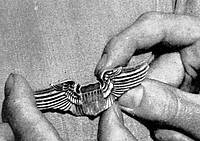 Most class books in the collection are from different air fields and training centers. Pilot training involved pre-flight, primary, basic, advanced, transition and unit training. After graduating one course, cadets were generally re-assigned to another air field for the next phase of their training. Interestingly, there seem to be no class books published for transition and unit training programs.
Most class books in the collection are from different air fields and training centers. Pilot training involved pre-flight, primary, basic, advanced, transition and unit training. After graduating one course, cadets were generally re-assigned to another air field for the next phase of their training. Interestingly, there seem to be no class books published for transition and unit training programs.
Here are the phases of pilot training as they were in 1944, adapted from The Official Guide to the Army Air Forces (New York: Pocket Books, Inc., May 1944).
Preflight School: 10 week course. Sea and air recognition, 30 hours; code, 48 hours; physics, 24 hours; math, 20 hours; maps and charts, 18 hours; daily physical and military training.
Primary Flying School: 10 week course. 70 hours in 125 to 225 hp open cockpit biplanes or low-wing monoplanes; 94 hours academic work in ground school; 54 hours military training.
Basic Flying School: 10 week course. 70 hours in a 450 horsepower basic trainer; 94 hours in ground school; 47 hours military training. By the end of basic school trainees have learned to fly a plane competently. Further training will teach them to fly a warplane the AAF way. Before the end of basic, trainees are classified–on the basis of choice and instructors’ reports–for single-engine training (fighter pilot) or 2-engine training (bomber, transport or 2-engine fighter pilot).
Advanced Flying Training: 10 week course (single-engine and 2-engine). 70 hours of flying; 60 hours of ground school; 19 hours military training. Single-engine trainees fly 600 horsepower AT-6s and take a course in fixed gunnery. Two-engine trainees fly AT-24s, AT-17s, AT-9s, or AT-10s. Based on performance and choice, they are earmarked for heavy or medium bombardment, transport, troop-carrier or 2-engine fighter. At the end of advanced training the graduates, single- and 2-engine, are awarded the silver pilot’s wings of the AAF and appointed flight officers or commissioned 2nd lieutenants.
Transition Flying Training: Before they begin to train in units, pilots learn to fly the type of warplane they will handle in combat. For example, those marked for B-26 assignment take a 10 week transition course of which 105 hours are spent flying B-26s and the rest in ground school. B-17 and B-24 pilots also get 105 hours 4-engine flying time and additional ground school training in a 10 week post-graduate transition course. Fighter pilots get a 5 week transition course; single-engine pilots fly 10 hours in P-40s; P-38 pilots take 10 hours in P-322s (modified P-38s). Gunnery is a part of fighter transition training. At the conclusion of transition training, pilots report to unit training groups where they are welded into fighting teams.
Hello, my uncle was P-38 pilot in 1942-43. In your last paragraph it looks like pilots going into P-38s only got 10 hours of actual P-38 flying time. Can that be true?! How many more hours were they given in unit training before going against Luftwaffe?
Thanks,
John Knight
Good question. It was a five week course and I know they would have had hundreds of hours of combined flight time during all their training. Apparently they didn’t get many hours in the actual equipment. In my reading of letters from a P-51 pilot, he felt he was well prepared and at the top of his game, both mentally and physically, to face the enemy.